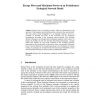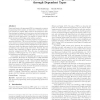130 search results - page 4 / 26 » Language networks: Their structure, function, and evolution |
BMCBI
2006
13 years 5 months ago
2006
Background: Cellular metabolism can be characterized by networks of enzymatic reactions and transport processes capable of supporting cellular life. Our aim is to find evolutionar...
HICSS
2006
IEEE
13 years 11 months ago
2006
IEEE
Abstract— Framework design is a multifaceted endeavor undertaken to promote reuse of software within a family of related applications. Traditional approaches involve either the e...
EDBT
2000
ACM
13 years 9 months ago
2000
ACM
the research activities. This abstract is to introduce the approach of a data model - EP data model. Its data structure is able to store as a finite set of nodes arbitrary effectiv...
ECAL
2007
Springer
13 years 9 months ago
2007
Springer
Energy flows in ecological systems which are determined by the structure of the ecological network influence the evolution of the network itself. The total system energy throughflo...
ICFP
2009
ACM
14 years 6 months ago
2009
ACM
Functional Reactive Programming (FRP) is an approach to reactive programming where systems are structured as networks of functions operating on signals. FRP is based on the synchr...


